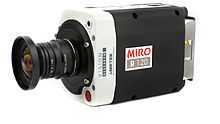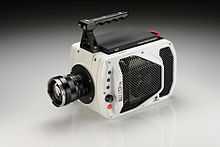Vision Research Phantom
 | |
| Industry | high-speed digital cameras |
|---|---|
| Founded | 1992 |
| Headquarters | Wayne, New Jersey |
| Products | Phantom Cameras: v-Series, Miro Series, Cinema line |
| Website | http://www.visionresearch.com/ |
Vision Research is an international company that manufactures high-speed digital cameras based in Wayne, New Jersey. Their cameras are marketed under the Phantom brand, and are used in a broad variety of industries including: defense, industrial product development,[1] manufacturing, automotive, scientific research,[2] and entertainment.[3] Vision Research is a business unit of the Materials Analysis Division of AMETEK Inc., a global manufacturer of electronic instruments and electromechanical devices.[4]
History
Originally founded as Photographic Analysis Company in 1950, they specialized in high-speed photographic research utilizing film cameras.[5] They applied high speed photography to numerous industries and applications, and designed, manufactured and marketed products specific to the high speed photographic needs of each industry.
In 1992, Photographic Analysis Company shifted focus to designing and fabricating high speed electronic imagers that did not rely on photographic film for imaging. They formed a separate entity for developing digital high-speed imaging systems known as Vision Research Inc. Their ultra slow motion digital video line of cameras are currently marketed under the Phantom trade mark[6] and was granted U.S. Patent #5,625,412 for high speed electronic digital imaging.[7]
Cameras and applications
The Phantom camera family consists of three camera lines and accessories.
The Miro line of small, lightweight cameras is used for mobile applications or situations where size and weight might be an issue in applications such as assembly line analysis, drop testing, particle image velocimetry (PIV), animal studies, bio-mechanical studies and automotive testing.

V-Series cameras are a broad line of high performance cameras used when applications demand the highest imaging speeds[8] and/or resolution. The v-Series[9] is used in applications such as ballistics testing, military research,[10] engine development, and medical research.


The third line of cameras are targeted at TV & Motion Picture production for live event broadcasts[11] and new media applications. The Phantom HD,[12] 65[13] and Flex cameras are extensively used to capture detail in digital cinema[14] and HD television productions[15] and have won an Academy Scientific and Technical Award in 2012[16] and a Technology & Engineering Emmy Award in 2010.[17] Two Phantom 65 cores are used for IMAX's 3D Digital camera.
Vision Research also does custom engineering and specialty cameras for unique applications.
References
- ↑ Carey, Bjorn (2 July 2013). "Stanford Students capture the flight of birds on very high-speed video". Stanford Newsletter. Retrieved 2 August 2013.
- ↑ Edd, John. "Edd Research group Vanderbilt University". Retrieved 2 August 2013.
- ↑ "ShotOnWhat?". Retrieved 2 August 2013.
- ↑ "About Vision Research". About Vision Research. Vision Research. Retrieved 21 September 2012.
- ↑ Jackson, Sharyn (2012-1-27). "Super Slo-Mo Developed by Jersey Family Firm". NJ Star Ledger. Retrieved 19 April 2012. Check date values in:
|date=(help) - ↑ "A PopSci Fourth of July". July 2012. PopSci. Retrieved 21 September 2012.
- ↑ "Patent 5,625,412". U.S. Patent Office. Retrieved 20 April 2012.
- ↑ "Best of What's New 2011". Bonnier Corporation. Retrieved 20 April 2012.
|first1=missing|last1=in Authors list (help) - ↑ "Digital System Captures The Invisible". R&D Magazine. 2002-08-08. Retrieved 20 April 2012.
|first1=missing|last1=in Authors list (help) - ↑ "Searching for Cleaner Fuel". Advanced Imaging Pro. May 2009. Retrieved 21 September 2012.
- ↑ "X-Mo Slow-Motion System used in World Series Broadcasts". Phantom HD high-speed camera, known as the X-MO slow-motion system. inerta Unlimited. Retrieved 21 September 2012.
- ↑ "Technical Specifications for Sherlock Holmes 3". Cameras used to Shoot the Movie Sherlock Holmes 3. IMDB. Retrieved 21 September 2012.
- ↑ "Using the Phantom 65 to shoot "In The Wild"". Phantom 65 used "In The Wild". AbelCine. Retrieved 21 September 2012.
- ↑ "Watch how this is painstakingly put together". Gizmodo. 18 May 2012. Retrieved 21 September 2012.
- ↑ "Using the Phantom Camera to shoot Slow-Motion scenes in Sherlock". Discusses using the Phantom Camera to capture slow-motion. Sherlockology. Retrieved 21 September 2012.
- ↑ "8 Scientific and Technical Achievements to Be Honored With Academy Awards". HollyWood Reporter. 1/5/12. Retrieved 20 April 2012. Check date values in:
|date=(help) - ↑ Morely, Hugh (2010-11-11). "Wayne Camera Firm Wins Emmy". Bergen Record. Retrieved 20 April 2012.